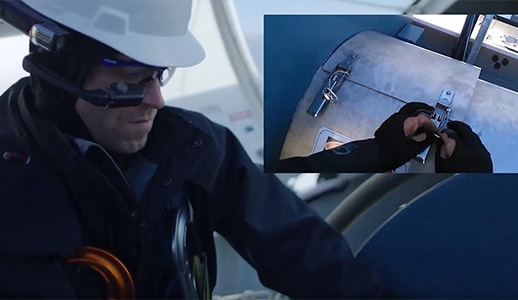Deliver device agnostic user experience with access to knowledge and choice of communication channels
It is important to understand that connectivity is critical to an industrial worker; be it a manufacturing technician working in a factory, or a maintenance technician servicing equipment at a customer site.

Industrial workers are increasingly facing challenges due to a growing degree of automation and the ever-increasing complexity of industrial machinery. They are sometimes asked to perform tasks that they are not fully trained in, or are sometimes at the boundaries of their knowledge and skills.
Engineers who design and deploy industrial systems are often one step removed from the field technicians, and they may not be fully aware of the skills gap in the field. It's trivial for engineers to pull up engineering drawings, perform failure analysis, review a procedure and even brainstorm solution options with a colleague.
However, technicians working on the manufacturing floor or within field teams don�t have such options, which can lead not only to productivity loss, but also cause stress and anxiety.
A Connected Worker solution aims to empower industrial workers by providing the same tools and support, that their office peers enjoy. By deploying emerging technologies, connected worker platforms can increase worker productivity far beyond current industry standards.
There are three elements that all leaders should keep in mind when deploying a connected worker platform.

Provide a choice of communication channels
Today�s industrial workforce today is a mix of baby-boomers, millennials and Gen Z. The technologies that these demographics use on a daily basis varies considerably and therefore the Connected Worker platform should support a variety of communication channels including chat, phone calls, and video calls.
I am still amazed by how some folks are solving highly technical problems just over a chat window, by sharing annotated pictures and recorded videos of a field problem. Sometimes engineers and experts at an offsite location need to see a piece of equipment in operation, listen to machine noise, and guide the technician through a series of steps to troubleshoot equipment.
The capability to switch to live video stream with options to annotate and share screens are essential in such scenarios. Providing multiple options for communication gives a field technician more confidence while at a customer site. They feel more integrated with the support team which results in better employee wellbeing and retention not to mention the leap in efficiencies.
Ensure seamless access to data and information
Manufacturing equipment in the field is connected with a set of sensors collecting continuous streams of data on process health, product quality, equipment diagnostics, and equipment performance.
While troubleshooting a piece of industrial equipment a technician might have to review operational data to understand failure modes and determine root causes. Today this data is not readily available for decision making in the field. A well designed connected worker platform will be able to parse this data, perform analytics and present findings in a field usable format
Another challenge faced by technicians who are working in a manufacturing plant, or at a customer site, is that they do not have access to procedure documents, work instructions, and troubleshooting guides.
Field teams usually carry binders of printed material to review few pages of relevant documentation, because they don�t know which pages of a trouble-shooting guide will be needed to do the work. Not only is this inefficient, but sometimes this may lead to procedural errors if the documentation in hand does not have the necessary information
A well designed connected worker platform solves this problem with AI-enabled document libraries where information can be retrieved with voice-activated intelligent keyword searches.
This will significantly improve efficiency in the field, reduce errors, and boosts employee confidence.
Build a device-agnostic user experience
On average a manufacturing or field technician will spend 80% of their time performing hands-on work and the rest of the time. The rest of the time is typically spent on site to site travel, or doing office work. The connected worker solution should meet the device preference in all these environments.
While they are doing hands-on work, industrial-grade smart glasses like RealWear HMT will assist technicians to review work-instructions and provide a hands-free connection to an offsite expert. But, a mobile application is more practical while they are on the road, and a web-application while working back at the office.
Below is a video of Realwear HMT-1 in action
A connected worker platform should provide workers the same experience on across all three environments. The user should be able to seamlessly switch between web, mobile and smart-glass applications to access data, information and human expertise.
The returns on investment (ROI) of implementing a well designed connected worker platform is not just measured in productivity gains. It has been proven that connected workers feel more empowered and have a heightened sense of safety and wellbeing at work.
You can use the SnapSupport ROI calculator to estimate the productivity gains at your organization.
SnapSupport's connected worker platform is available on mobile, web and smart-glasses. It connects industrial workers in the field to their offsite expert to collaboratively solve problems, collect field inspection data, and provide access to procedure documentation, work-instructions and troubleshooting guides.